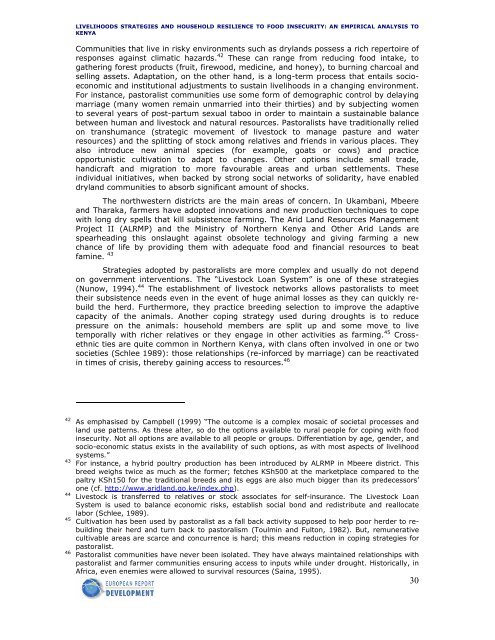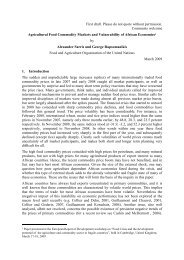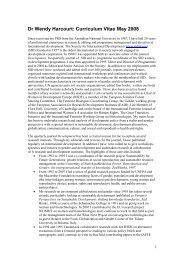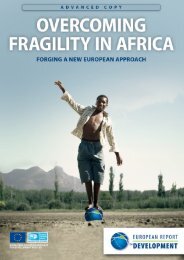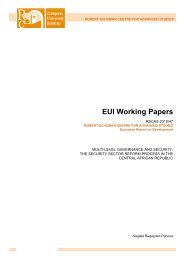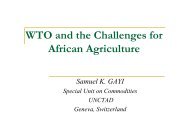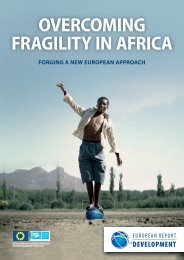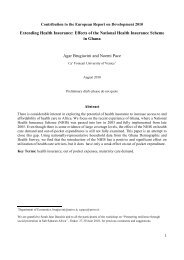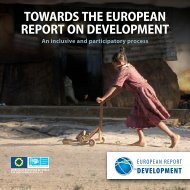LiveLihoods strategies and househoLd resiLience to Food insecurity ...
LiveLihoods strategies and househoLd resiLience to Food insecurity ...
LiveLihoods strategies and househoLd resiLience to Food insecurity ...
Create successful ePaper yourself
Turn your PDF publications into a flip-book with our unique Google optimized e-Paper software.
LIVELIHOODS STRATEGIES AND HOUSEHOLD RESILIENCE TO FOOD INSECURITY: AN EMPIRICAL ANALYSIS TO<br />
KENYA<br />
Communities that live in risky environments such as dryl<strong>and</strong>s possess a rich reper<strong>to</strong>ire of<br />
responses against climatic hazards. 42 These can range from reducing food intake, <strong>to</strong><br />
gathering forest products (fruit, firewood, medicine, <strong>and</strong> honey), <strong>to</strong> burning charcoal <strong>and</strong><br />
selling assets. Adaptation, on the other h<strong>and</strong>, is a long-term process that entails socioeconomic<br />
<strong>and</strong> institutional adjustments <strong>to</strong> sustain livelihoods in a changing environment.<br />
For instance, pas<strong>to</strong>ralist communities use some form of demographic control by delaying<br />
marriage (many women remain unmarried in<strong>to</strong> their thirties) <strong>and</strong> by subjecting women<br />
<strong>to</strong> several years of post-partum sexual taboo in order <strong>to</strong> maintain a sustainable balance<br />
between human <strong>and</strong> lives<strong>to</strong>ck <strong>and</strong> natural resources. Pas<strong>to</strong>ralists have traditionally relied<br />
on transhumance (strategic movement of lives<strong>to</strong>ck <strong>to</strong> manage pasture <strong>and</strong> water<br />
resources) <strong>and</strong> the splitting of s<strong>to</strong>ck among relatives <strong>and</strong> friends in various places. They<br />
also introduce new animal species (for example, goats or cows) <strong>and</strong> practice<br />
opportunistic cultivation <strong>to</strong> adapt <strong>to</strong> changes. Other options include small trade,<br />
h<strong>and</strong>icraft <strong>and</strong> migration <strong>to</strong> more favourable areas <strong>and</strong> urban settlements. These<br />
individual initiatives, when backed by strong social networks of solidarity, have enabled<br />
dryl<strong>and</strong> communities <strong>to</strong> absorb significant amount of shocks.<br />
The northwestern districts are the main areas of concern. In Ukambani, Mbeere<br />
<strong>and</strong> Tharaka, farmers have adopted innovations <strong>and</strong> new production techniques <strong>to</strong> cope<br />
with long dry spells that kill subsistence farming. The Arid L<strong>and</strong> Resources Management<br />
Project II (ALRMP) <strong>and</strong> the Ministry of Northern Kenya <strong>and</strong> Other Arid L<strong>and</strong>s are<br />
spearheading this onslaught against obsolete technology <strong>and</strong> giving farming a new<br />
chance of life by providing them with adequate food <strong>and</strong> financial resources <strong>to</strong> beat<br />
famine. 43<br />
Strategies adopted by pas<strong>to</strong>ralists are more complex <strong>and</strong> usually do not depend<br />
on government interventions. The “Lives<strong>to</strong>ck Loan System” is one of these <strong>strategies</strong><br />
(Nunow, 1994). 44 The establishment of lives<strong>to</strong>ck networks allows pas<strong>to</strong>ralists <strong>to</strong> meet<br />
their subsistence needs even in the event of huge animal losses as they can quickly rebuild<br />
the herd. Furthermore, they practice breeding selection <strong>to</strong> improve the adaptive<br />
capacity of the animals. Another coping strategy used during droughts is <strong>to</strong> reduce<br />
pressure on the animals: household members are split up <strong>and</strong> some move <strong>to</strong> live<br />
temporally with richer relatives or they engage in other activities as farming. 45 Crossethnic<br />
ties are quite common in Northern Kenya, with clans often involved in one or two<br />
societies (Schlee 1989): those relationships (re-inforced by marriage) can be reactivated<br />
in times of crisis, thereby gaining access <strong>to</strong> resources. 46<br />
42 As emphasised by Campbell (1999) “The outcome is a complex mosaic of societal processes <strong>and</strong><br />
l<strong>and</strong> use patterns. As these alter, so do the options available <strong>to</strong> rural people for coping with food<br />
<strong>insecurity</strong>. Not all options are available <strong>to</strong> all people or groups. Differentiation by age, gender, <strong>and</strong><br />
socio-economic status exists in the availability of such options, as with most aspects of livelihood<br />
systems.”<br />
43 For instance, a hybrid poultry production has been introduced by ALRMP in Mbeere district. This<br />
breed weighs twice as much as the former; fetches KSh500 at the marketplace compared <strong>to</strong> the<br />
paltry KSh150 for the traditional breeds <strong>and</strong> its eggs are also much bigger than its predecessors’<br />
one (cf. http://www.aridl<strong>and</strong>.go.ke/index.php).<br />
44 Lives<strong>to</strong>ck is transferred <strong>to</strong> relatives or s<strong>to</strong>ck associates for self-insurance. The Lives<strong>to</strong>ck Loan<br />
System is used <strong>to</strong> balance economic risks, establish social bond <strong>and</strong> redistribute <strong>and</strong> reallocate<br />
labor (Schlee, 1989).<br />
45 Cultivation has been used by pas<strong>to</strong>ralist as a fall back activity supposed <strong>to</strong> help poor herder <strong>to</strong> rebuilding<br />
their herd <strong>and</strong> turn back <strong>to</strong> pas<strong>to</strong>ralism (Toulmin <strong>and</strong> Ful<strong>to</strong>n, 1982). But, remunerative<br />
cultivable areas are scarce <strong>and</strong> concurrence is hard; this means reduction in coping <strong>strategies</strong> for<br />
pas<strong>to</strong>ralist.<br />
46 Pas<strong>to</strong>ralist communities have never been isolated. They have always maintained relationships with<br />
pas<strong>to</strong>ralist <strong>and</strong> farmer communities ensuring access <strong>to</strong> inputs while under drought. His<strong>to</strong>rically, in<br />
Africa, even enemies were allowed <strong>to</strong> survival resources (Saina, 1995).<br />
30


